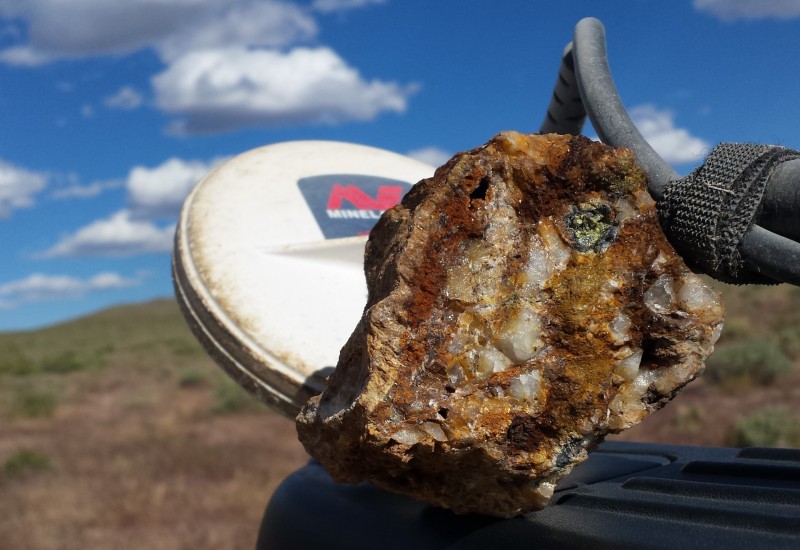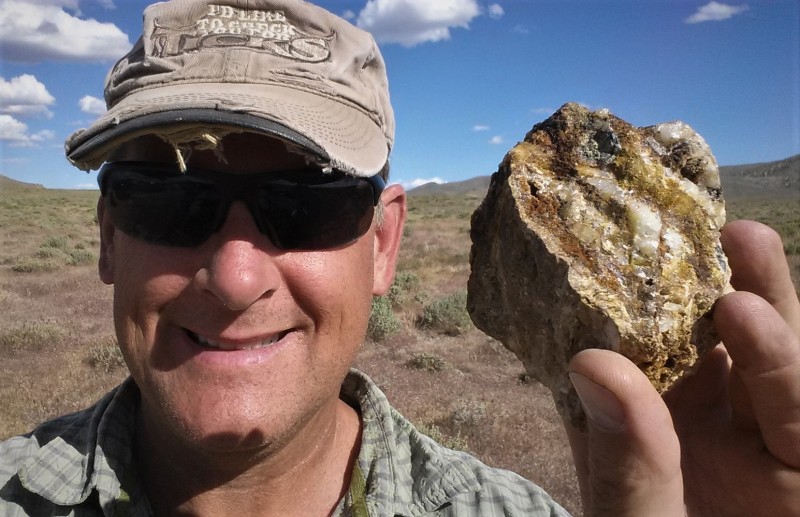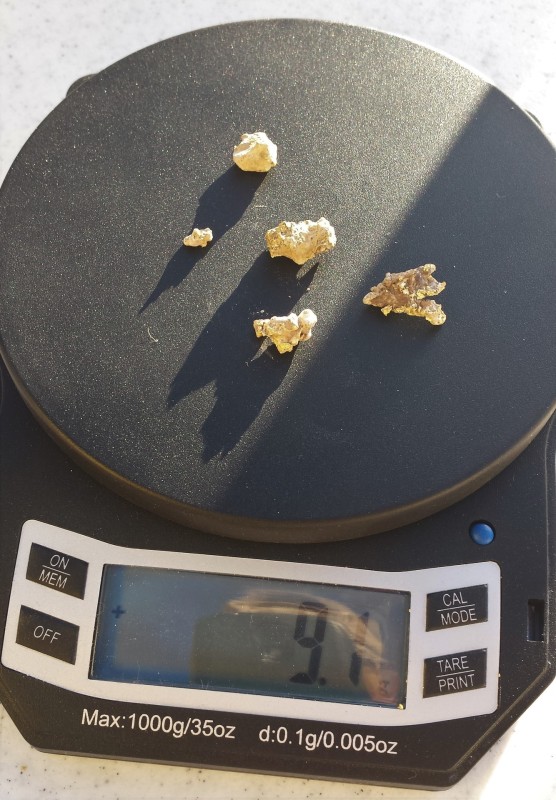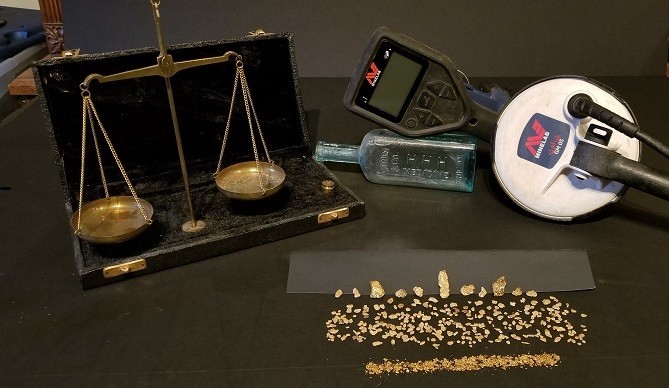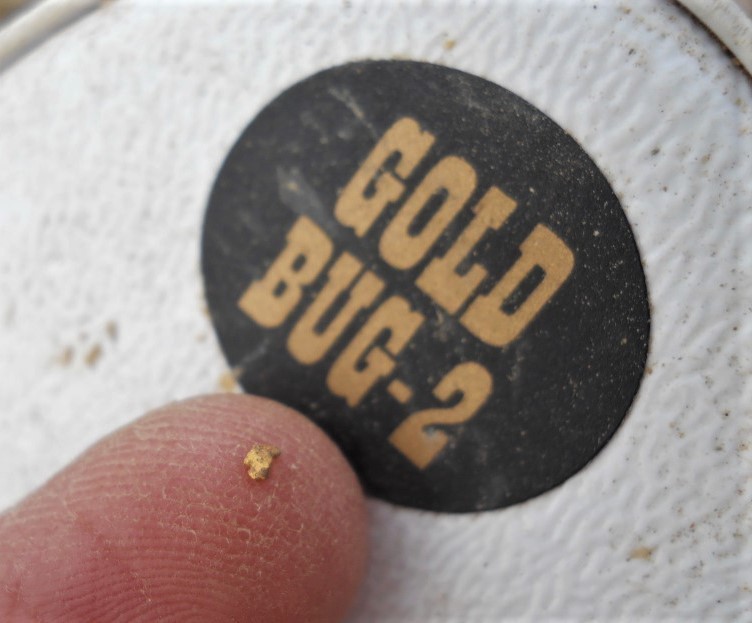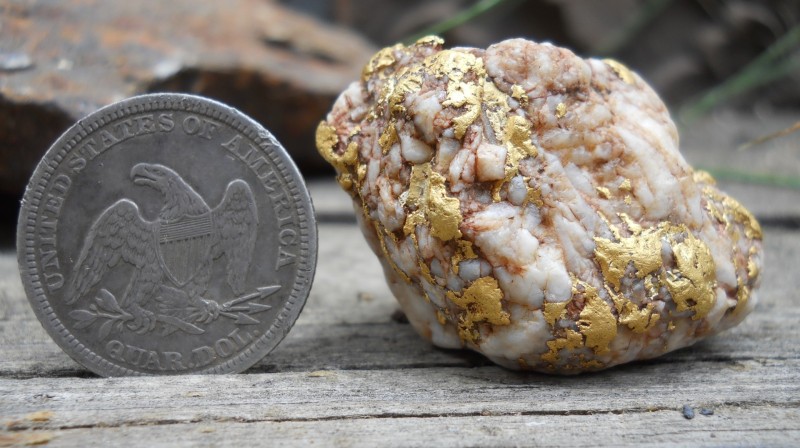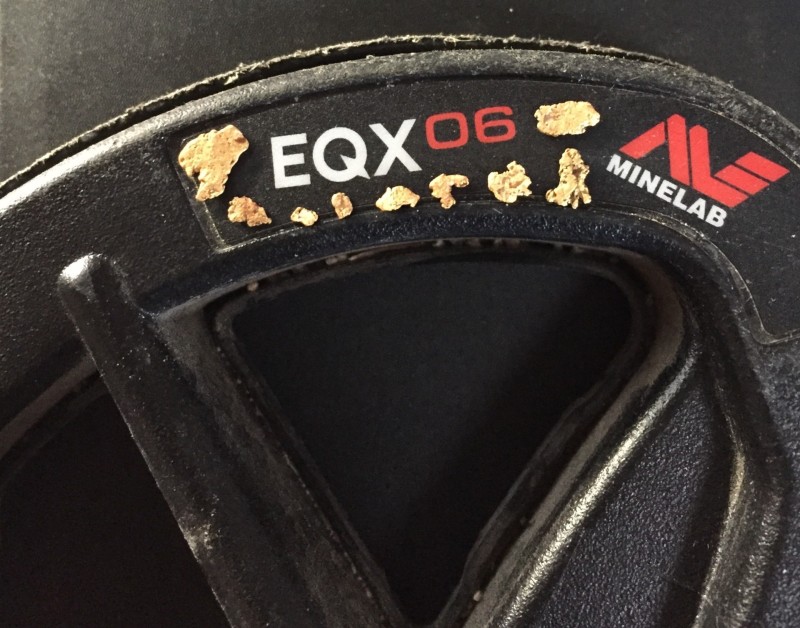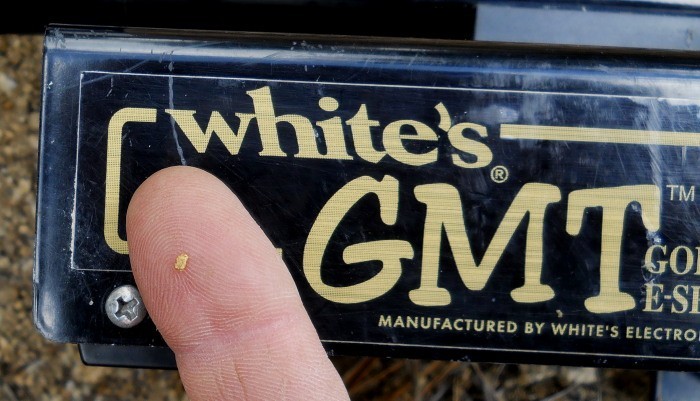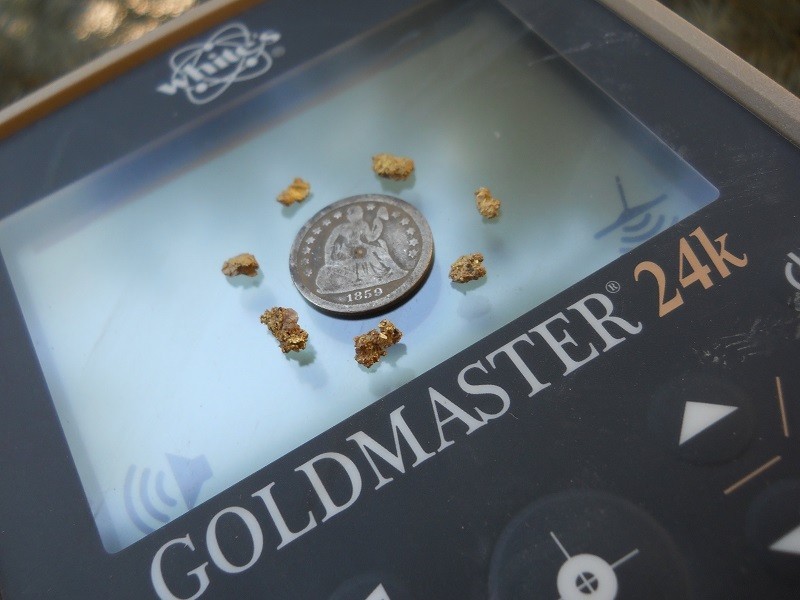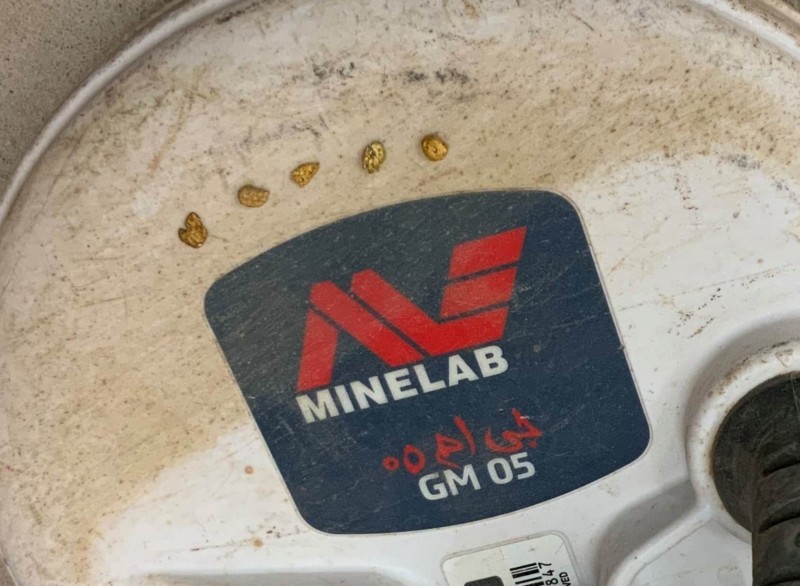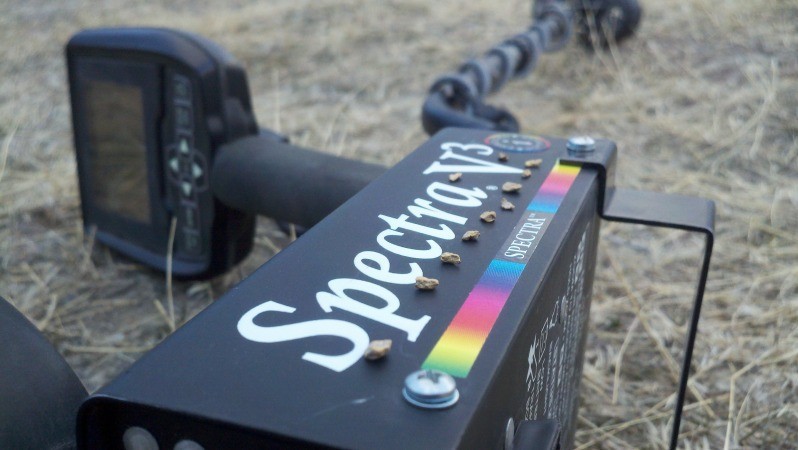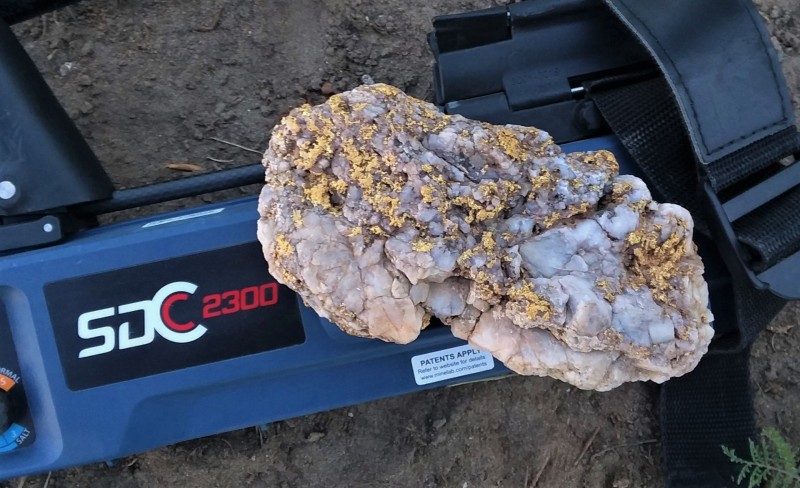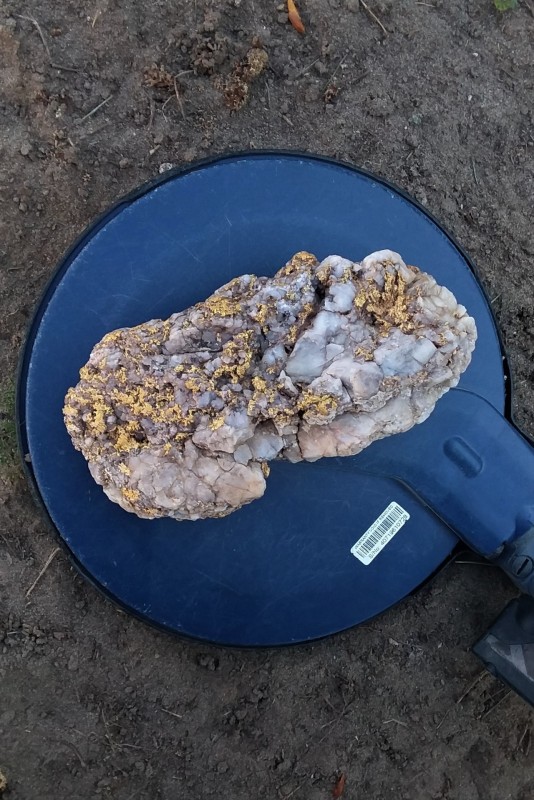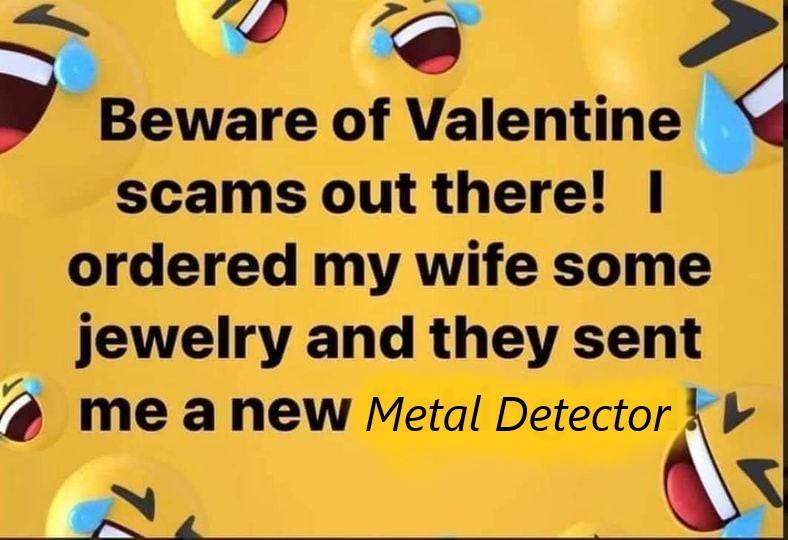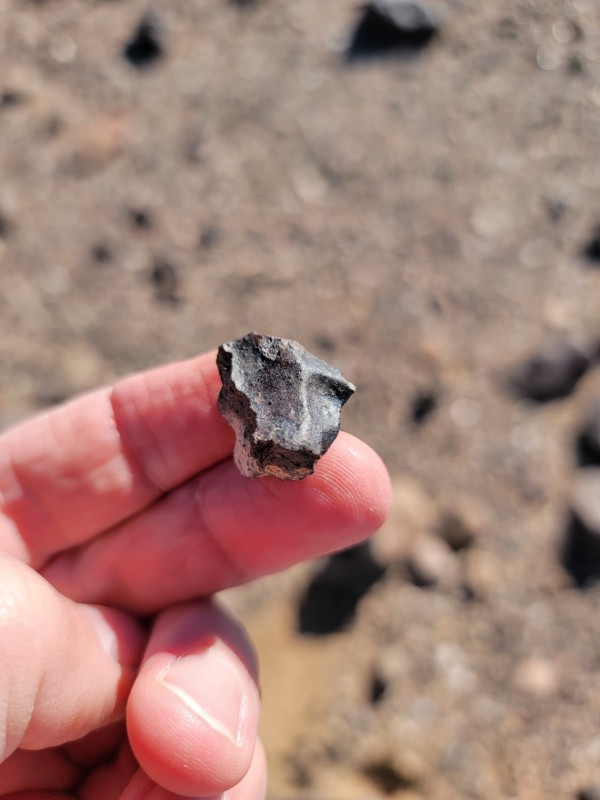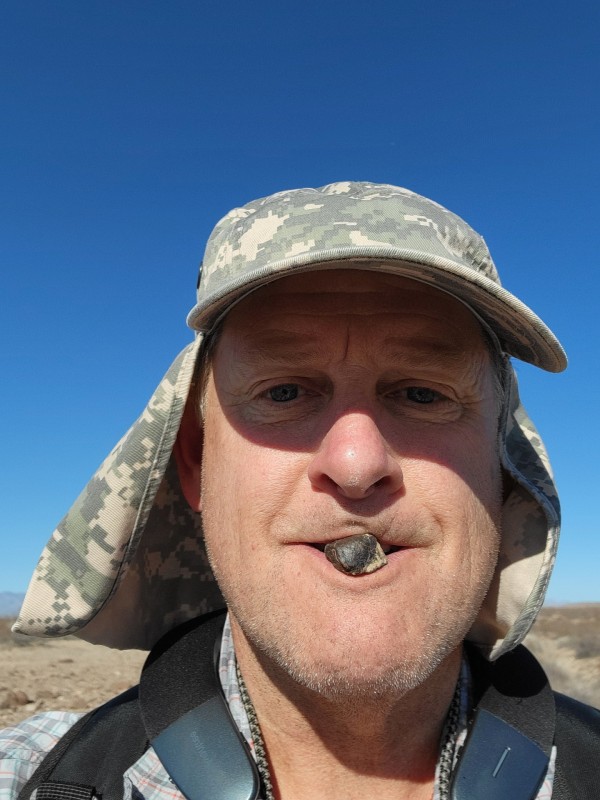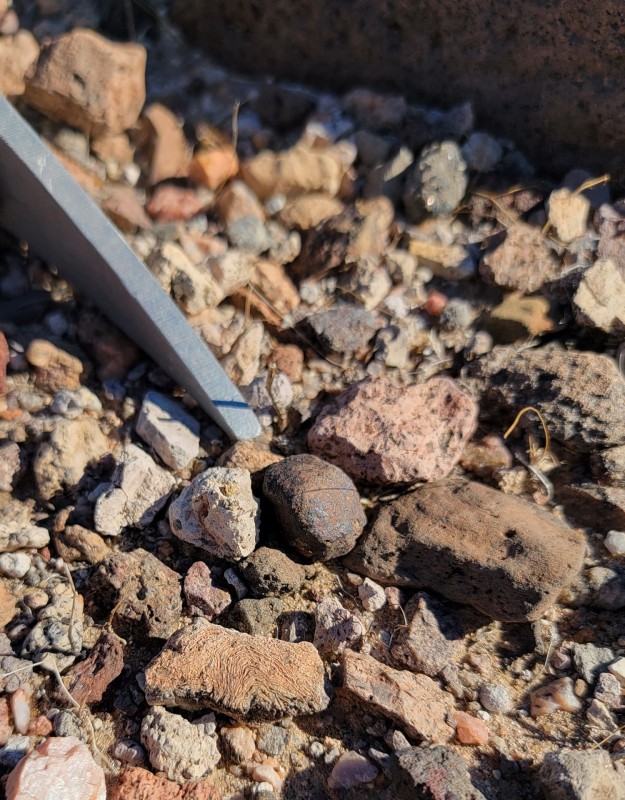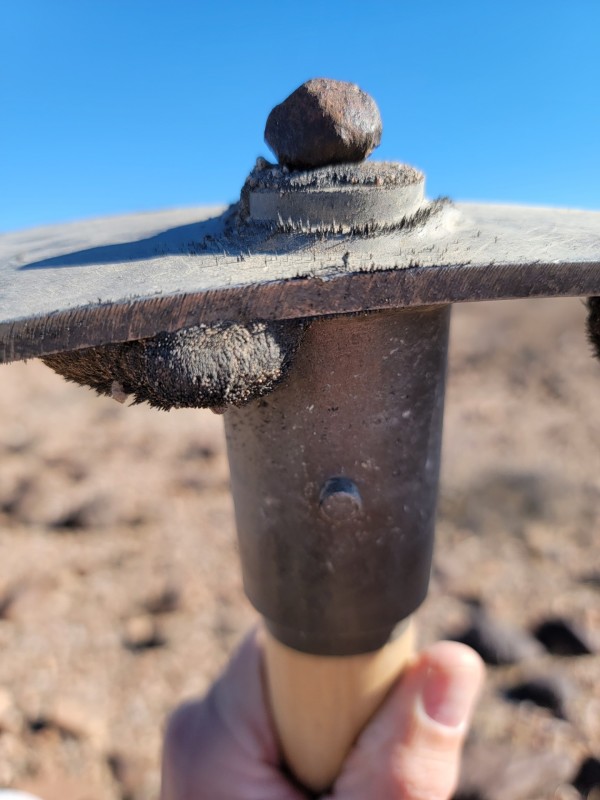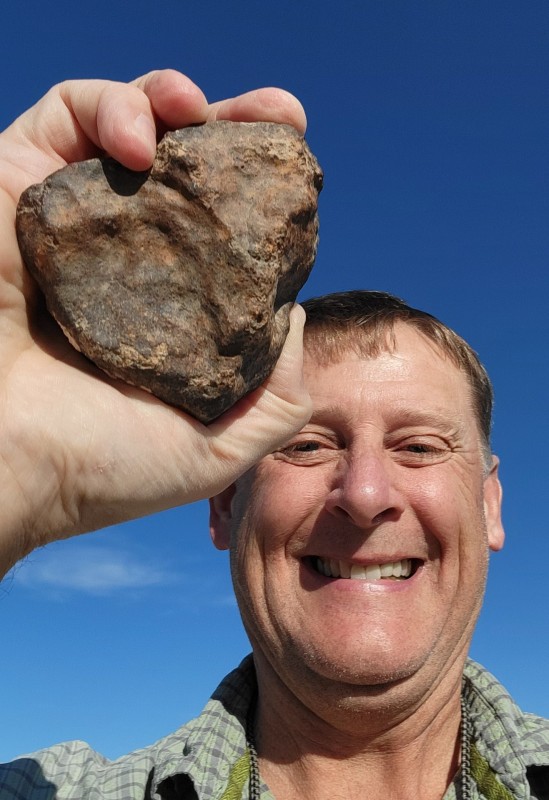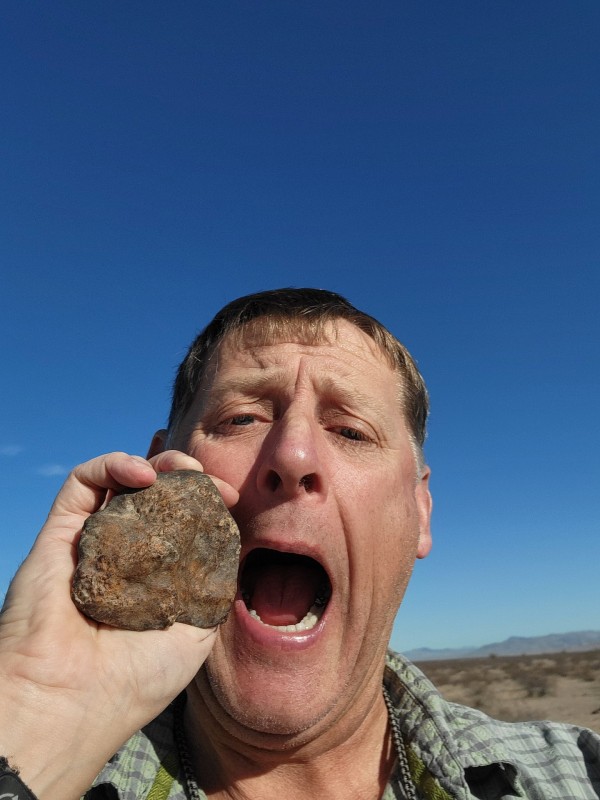-
Posts
2,197 -
Joined
-
Last visited
Content Type
Forums
Detector Prospector Home
Detector Database
Downloads
Everything posted by Gerry in Idaho
-
As someone who travels many states and a few countries while collecting a variety of gold pieces with detectors and coils, I've realized the importance of having more than 1 detector tool. So many variables out there and each sites has different situations and sometimes varying gold types. If you want best potential for success you should have a VLF and a big detector. So many times I've planned on hunting an area with said machine and then get there to realize just around the bend is a more profitable situation to hunt but I need a different detector technology. Knowing them and when to switch is key. These two pics are the same rock from NV and I went down there expecting to use my GPZ-7000. When I seen the type of gold and the source, I realized my GM-1000 had best potential. It had approx 4 grams of gold in it and my GPZ-7000 heard....not a peep. Then down below, I was able to get a few others with the 7000 that were deeper than what the Monster could do.
-
Someday somewhere there will be a new list of names, sizes and finders of such mammoth Au discoveries. We keep reaching father off the beaten paths and deeper into the ground. So many places have yet a coil over them but time will tell. Thanks for sharing.
-

Mother Nature Never Ceases To Amaze Me!
Gerry in Idaho replied to Glenn in CO's topic in Detector Prospector Forum
Stunning finds and amazing cleaning. Hopefully you are getting top dollar as those are museum worthy. Well earned and thanks for sharing. -
Good catch on the gold in the pic and that's typically true. It all came from the same area, but the flash of the camera changed the gold a little farther away. You'll see the same thing when looking at the gold scale. The front scale looks darker than the back scale but they are the same. Yes the GPX-6000 is almost like a sensitive VLF that turned into PI depth and stability in my opinion. I've laughed myself a few times at the capabilities of the GPX-6000.
-
Great feedback everyone and I hope this truly does help some of the newer hunters. Let's play the odds for a bit and see who usually wins. That same thinking is true today and especially for the new nugget hunter wanting to dig a piece of gold. Old time Prospectors from years past running the sluice box, or a water cannon, gold pan and even big iron dredges played the odds of recovering gold. Even todays changing advanced technology and big mining companies play the odds at collecting Au. Their philosophy holds true today and is to find the most plentiful kind of gold that can be recovered at the cheapest cost. 100+ yrs ago it was the flour gold that kept the miners fed. Sure there was the occasional nugget found, but the majority of gold recovered in the 1800's and early 1900's was flour. Now jump forward 100+ yrs and the big mineral companies are collecting microscopic gold that naked eye can't see. Conclusion is nuggets are rare and the bigger they get the more rare they become. As a veteran nugget hunter myself of 25+ yrs, I know for a fact the majority of my recovered gold nuggets were smaller pieces. I've had 100+ nugget days on occasion and also found 40+ little nuggets in 1 hole before. The collection many folks share and pics tell the same story and show mostly smaller nuggets. Detector manufactures have caught on as well. Each time a new VLF gold detector comes out, it's usually compared to see how small of gold it can find. Heck todays higher dollar PI's and ZVT technology detectors do the same thing. They get better at finding the smaller nuggets than their older models before. It's the odds of having success at going home with a nugget, no matter what the size. I don't know if these numbers are fact and never did a google search but will say from my own experience. For every 1 pound nugget, there are 20 of the 1 ounce nuggets. For each 1 oz there's approx 20 quarter ounce nuggets. For each 1/4 oz (approx 7.8 gram) chunk I have probably found an average of 50 of the 2 gram size. Again, from 2 gram to 1 gram is probably another 50. Now here is where things really get going. I'm willing to say it, but I'm sure for each 1 gram pea size nugget, the average is closer to 100 .1 gram nuggets. I won't worry about anything less but hope you get my point. It holds true today just like it did 150 yrs ago. There's more smaller gold nuggets than bigger ones and more flour gold than nuggets and more microscopic gold than flour. So with my findings, the best chance of Success for a beginner detectorist is to set your detector up for the most plentiful size of gold still out there that a detector can hear (smaller nuggets). Pic below is from my customer in MT with his GM-1000 and when you look at all the gold, you'll notice much more smaller stuff. - On many detectors I have tested, the smaller coil is actually deeper on tiny gold than the stock coil. - Smaller coil sees less mineralized soils as it has a smaller footprint so you can turn the SENS/GAIN up. - Smaller coil on many detectors runs smoother, sees less EMI, and is more stable than stock coil. - The ID system on many detectors reads more accurately on a small nugget near surface than the stock coil as the bigger coil again sees more mineralization and it's harder to read the same small nugget. (note, I don't recommend newbies to rely on ID systems when chasing tiny gold). All detectors can be fooled. - Smaller coils can get under bushes, between rocks and in cracks/crevices easier and that's sometimes the places nuggets light to get caught up or hide. - Small coils give cleaner signal response to smaller nuggets than stock coil so you can hear it better. - Small coil is lighter in weight so the operator can hunt longer without fatigue, especially when side hilling. - The average person who purchases a detector uses the coil that comes with it. Many times, the VLF detectors do not come with the small coil (yes I know GM-1000 does). You don't want to be average and be using the same size coil in the same areas the other guys hunt. The above mentioned and a few other reasons is why when my Field Staff/I prefer that our customers coming to the Field Training to put on the smallest coil they have. It ups your chance of Success. For a beginner nugget hunter, SUCCESS of any size gold is better than NO GOLD. Getting to hear the rattle of those few tiny nuggets in the pill bottle on the way home is much more happier for the detectorist than his buddy with rattling nothing. Anyone else who wants to add to this please do..... This info is just my opinion and I realize there are always exceptions. Happy Hunting.
-

Gold Monster Iron Signals Problem
Gerry in Idaho replied to Machineman's topic in Detector Prospector Forum
Any nugget no matter the size can be fooled by every detector known. There is always a certain depth that ID machines can not properly identify the target. The other thing to watch is the matrix of the soil and the more mineralized the soil the less accurate and depth the ID machine has. Part of the reason I prefer to hunt bigger gold in tailing piles is the lack of mineralized soils to mess with the ID of a detector, especially VLF. On the flip side hot rocks can mask a good chunk of gold as well. -

World Class Arizona Nugget Recent Find
Gerry in Idaho replied to Gerry in Idaho's topic in Detector Prospector Forum
Steve, The find is pretty much as is and has not been cleaned as it didn't need it. Yes some pieces have the orange/red iron staining like the find I made below in Australia. Then there's the ones that come out pretty clean of iron like below. As for the kind of host rock/quartz. I'm not a geologist so not sure if Bull Quartz is or is not the term. -
We have a new season of gold hunting just about to start and I've already seen a couple guys out and about making some finds of the heavy yellow metal. With the new season about to start is a few beginner nugget hunter want-a-bees. Let's take the time to share some of the knowledge we have learned. I myself recommend newer users to the nugget hunting scene to run as small of a coil on their VLF gold detector as possible. I have my reasoning for this, but before I say, I'd like to hear from others, your input, thoughts and experiences. What's interesting is the manufactures stock coil is usually larger than what I prefer and recommend for newer hunters. Thanks for helping out the newbies everyone.
-
I've been fortunate enough to find a few bits in WY and witnessed a few ouncer size chunks as well. Nice write up and pics.
-
Very nice chunky gold Chris and I enjoyed your geology video as well.
-

World Class Arizona Nugget Recent Find
Gerry in Idaho replied to Gerry in Idaho's topic in Detector Prospector Forum
Yes it's important to know where it was found as that could help with the value at the time of the sale. Another part of the story that some of us are missing and Rob brought it up as well: This is incredible monster find is pretty recent and that is amazing to me. Just goes to show, there are big one still out there. Remember, 2 yrs ago this (see attached pics) monster specimen was recovered in AZ by one of my customers using an SDC-2300. 38 ozt is the total weight of the specimen and it has over a pound of gold. Yes there are some big gold chunks still out there and more to come. Happy Hunting. -

Gold Monster Iron Signals Problem
Gerry in Idaho replied to Machineman's topic in Detector Prospector Forum
Welcome to DP Tom and hoping your new GM-1000 is as productive as you can make it. As for different pitches of the tone on the Monster and between it being iron and nonferrous. Yes some iron targets can give a scratchy or shorter chirpy sounds, but please do not rely on that 100% as you'll get bitten. I've had found tell me they can hear the difference of lead and gold. I call BS. I have folks who think they can hear the difference of bullet casings and gold, again I call BS. With a detector like the Monster and so many other gold machines, you should not rely on what your ear hears as much when it comes to IDing targets and trying to differentiate the difference. Now I will give an example of how my ear can help me ID some gold from other undesired targets. Say a particular site has small half grain of rice nuggets across a bedrock shelf or bottom of a gully and all these nuggets are about the same size. Lets also say a rabbit hunter was in there with a 22 rifle and there are casings scattered on the same area. At that time an experienced ear might hear the signal strength and width of the half grain rice gold nugget vs the .22 shell casing as they are different in size and density. Now if there happens to be a 1 gram nugget mixed in with the smaller nuggets and .22 casings...and you still tried to use the signal strength/width strategy, you'll miss the 1 grammer. Above is a prime example of the Equinox 800's identification capabilities as it will easily read and give different ID #'s of the small 1/2 grain rice nuggets vs the .22 casing. So with the NOX, I get the same signal with/strength and also VDI #'s. But as mentioned by others....when in doubt-check it out. -

Black Gold From Arizona And Hard To Find.
Gerry in Idaho replied to Gerry in Idaho's topic in Detector Prospector Forum
I like your way of hunting meteorites and you can certainly cover some ground. What's the best one you have ever found doing that? -
It's worse than I thought. I tried to double down and order her a 2nd nice piece of jewelry. Ended up getting an XP Deus 2. I'm in serious hot water now.
-

Black Gold From Arizona And Hard To Find.
Gerry in Idaho replied to Gerry in Idaho's topic in Detector Prospector Forum
He decided to hunt the more expensive Au rocks but I know he has found Meteorites in times past and is well versed at it. He was my mentor on previous trip and taught me alot. -

Black Gold From Arizona And Hard To Find.
Gerry in Idaho replied to Gerry in Idaho's topic in Detector Prospector Forum
So many Hot Rocks in the area it's just faster to use a PI unit. Yes I've probably tossed a few in my early days with the bath water. -
www.gerrysdetectors.com is a great website to order gold rings. You end up with a detector every time.
-

Black Gold From Arizona And Hard To Find.
Gerry in Idaho replied to Gerry in Idaho's topic in Detector Prospector Forum
I didn't even attempt to chase a nugget on this trip. Set your mind to it and go. -
What's interesting about the D mint mark for those coins. It is not for DENVER. Back in the 90's one of our local club members found a beautiful gold coin here in Boise, Idaho. Anyone finding a gold coin makes big news around here and when he told me the year and mint mark, I could not figure out why, as Denver mint was not known back then. It was not until I was able to see the coin in person and realize yes it was a D mint mark and more research revealed the rare mint from Georgia (Dahlonega). I tried to purchase it back then, but it was his best coin find ever so I totally understand why he wanted to keep it. Thanks for bringing back memories.
-

Black Gold From Arizona And Hard To Find.
Gerry in Idaho posted a topic in Detector Prospector Forum
Sorry I have not been posting for a while, but you know I get the itch to swing and just do it. I just returned from a nice short and warm weather trip down South in Arizona. Tried my luck again at Meteorite Hunting with a metal detector. As a veteran detectorist with near 50 yrs, I can assure you this. I know how hard it is to find gold, but swinging a detector across the desert floor while trying to find space rocks, put my body to a real test. In fact, I'll have to admit, chasing meteorites is harder than hunting gold nuggets. Yes I found a few and walked/hiked more miles than I care to talk about. I didn't take a pick of my pack, but loaded it with drinks, my typical survival gear, a days worth of food and off I was. Found out really fast, I am only getting about 7 to 8 hrs of actual use on 1 battery of my GPX-6000, but luckily I took a spare. The pics are of some Black Gold Arizona meteorites and no I couldn't fit the big one in my mouth. Has anyone else tried hunting meteorites before and do you agree how hard it is? Maybe it was because this was my 1st trip for 2022 and my body has not been tuned yet. -
Very nice gold indeed and keep us posted of the nuggets Condor sniffs out with the GPX-6000.
-

Rye Patch Deep Freeze Hunt!
Gerry in Idaho replied to LuckyLundy's topic in Detector Prospector Forum
Very nice looking nuggets for sure. Bearing the cold chill is rough until you dig a nice piece of heavy yellow metal. You warms up real quick like when those are rattling in the ol bottle. Well done.


